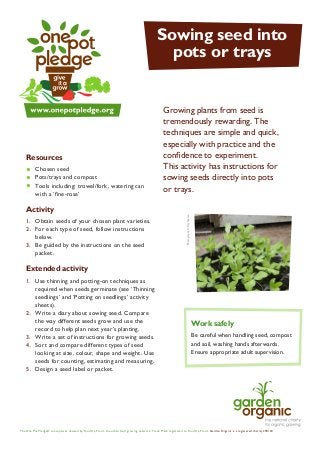Contenu connexe
Plus de Teacher Organic Gardening Guides (17)
Sowing Seed into Pots or Trays - Teacher + Student Guide
- 1. Sowing seed into
pots or trays
Resources
• Chosen seed compost
• Pots/trays and trowel/fork, watering can
Tools
• with aincluding:
‘fine-rose’
Growing plants from seed is
tremendously rewarding. The
techniques are simple and quick,
especially with practice and the
confidence to experiment.
This activity has instructions for
sowing seeds directly into pots
or trays.
1. btain seeds of your chosen plant varieties.
O
2. each type of seed, follow instructions
For
below.
3. e guided by the instructions on the seed
B
packet.
Photography © Ray Spence
Activity
Extended activity
1.
2.
3.
4.
5.
U
se thinning and potting-on techniques as
required when seeds germinate (see ‘Thinning
seedlings’ and ‘Potting on seedlings’ activity
sheets).
Write a diary about sowing seed. Compare
the way different seeds grow and use the
record to help plan next year’s planting.
W
rite a set of instructions for growing seeds.
S
ort and compare different types of seed
looking at size, colour, shape and weight. Use
seeds for counting, estimating and measuring.
Design a seed label or packet.
Work safely
Be careful when handling seed, compost
and soil, washing hands afterwards.
Ensure appropriate adult supervision.
The One Pot Pledge® concept was devised by Food Up Front, the urban food growing network. Trade Mark registered to Food Up Front. Garden Organic is a registered charity 298104
- 2. All Photography © Ray Spence
Instructions for sowing seed in pots and trays
1. Fill the container with organic, peat-free seed
compost. This compost will have all the
nutrients the seedlings need to germinate
and grow for a few weeks, without adding extra
fertiliser.
2. Firm the surface of the compost with something
flat, like the bottom of another pot, or tap the
container on the bench to settle the compost.
Do not press the compost down hard as this
squeezes out too much air and the seedlings
won’t grow well.
3. Sow larger seeds individually, covering with
compost (no deeper than twice the size of
the seed).
4. Tap smaller seeds off the palm of your hand.
Also sprinkle seeds by taking a pinch between
finger and thumb.You can also mix small seeds
with the same bulk of fine sand and then sow
(for more even distribution).
5. Water using a watering can with a fine-rose end
or stand the container in a tray of water and
allow the water to soak up from below until the
surface is just damp. Do not saturate as this also
reduces the air in the compost. Leave to drain.
2/3
- 3. 6. Cover seed with sieved compost and firm
lightly so the seed and compost make good
contact. Leave very small seeds uncovered or
use a thin layer of vermiculite (very fine mineral
rock).
7. Label each container (or group of pots) with
the date of sowing, crop and variety name.
For some crops, sow again every two to four
weeks for a ‘succession’ of harvests during the
season, eg carrots, lettuce, radish, salad onion.
8. Lightly water again if needed using a
watering can with a fine-rose end.
9. Once seeds have germinated (typically
one-three weeks), thin or pot-on as required.
Notes
The method is the same for whichever type of pot or tray you use, whether bought or a
recycled container, eg margarine tubs with added drainage holes.
Individual pots are useful for larger seeds.
Seed-trays are good for getting as many seedlings as possible or if unsure of the likely
germination rate. Seedlings will need potting-on before transplanting.
Trays divided in modules are available in different sizes and suit most seeds. Seedlings
can then be transplanted with minimum root disturbance. You can also make your own, see
‘Making a paper pot’ activity.
Seed can sometimes be sown directly into larger containers.
•
•
•
•
Top tip - The right conditions
Greenhouse
Windowsill
Outdoors
Seedlings deprived of light
3/3
Photography © Ray Spence
Place your pot or tray in a location with adequate warmth and shelter. Keep moist and in a
light position for even and fast growth.

